Related Research Articles

A space telescope is a telescope in outer space used to observe astronomical objects. Suggested by Lyman Spitzer in 1946, the first operational telescopes were the American Orbiting Astronomical Observatory, OAO-2 launched in 1968, and the Soviet Orion 1 ultraviolet telescope aboard space station Salyut 1 in 1971. Space telescopes avoid several problems caused by the atmosphere, including the absorption or scattering of certain wavelengths of light, obstruction by clouds, and distortions due to atmospheric refraction such as twinkling. Space telescopes can also observe dim objects during the daytime, and they avoid light pollution which ground-based observatories encounter. They are divided into two types: Satellites which map the entire sky, and satellites which focus on selected astronomical objects or parts of the sky and beyond. Space telescopes are distinct from Earth imaging satellites, which point toward Earth for satellite imaging, applied for weather analysis, espionage, and other types of information gathering.
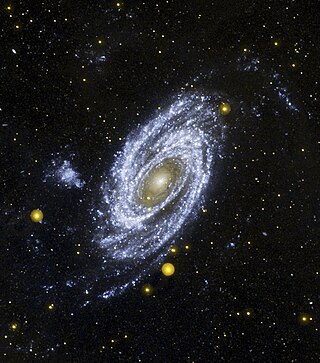
Ultraviolet astronomy is the observation of electromagnetic radiation at ultraviolet wavelengths between approximately 10 and 320 nanometres; shorter wavelengths—higher energy photons—are studied by X-ray astronomy and gamma-ray astronomy. Ultraviolet light is not visible to the human eye. Most of the light at these wavelengths is absorbed by the Earth's atmosphere, so observations at these wavelengths must be performed from the upper atmosphere or from space.

NASA's series of Great Observatories satellites are four large, powerful space-based astronomical telescopes launched between 1990 and 2003. They were built with different technology to examine specific wavelength/energy regions of the electromagnetic spectrum: gamma rays, X-rays, visible and ultraviolet light, and infrared light.
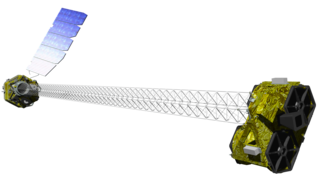
NuSTAR is a NASA space-based X-ray telescope that uses a conical approximation to a Wolter telescope to focus high energy X-rays from astrophysical sources, especially for nuclear spectroscopy, and operates in the range of 3 to 79 keV.

International Ultraviolet Explorer, was the first space observatory primarily designed to take ultraviolet (UV) electromagnetic spectrum. The satellite was a collaborative project between NASA, the United Kingdom's Science and Engineering Research Council and the European Space Agency (ESA), formerly European Space Research Organisation (ESRO). The mission was first proposed in early 1964, by a group of scientists in the United Kingdom, and was launched on 26 January 1978, 17:36:00 UTC aboard a NASA Thor-Delta 2914 launch vehicle. The mission lifetime was initially set for 3 years, but in the end, it lasted 18 years, with the satellite being shut down in 1996. The switch-off occurred for financial reasons, while the telescope was still functioning at near original efficiency.

AstroSat is India's first dedicated multi-wavelength space telescope. It was launched on a PSLV-XL on 28 September 2015. With the success of this satellite, ISRO has proposed launching AstroSat-2 as a successor for AstroSat.

The Astronomical Netherlands Satellite was a space-based X-ray and ultraviolet telescope. It was launched into Earth orbit on 30 August 1974 at 14:07:39 UTC in a Scout rocket from Vandenberg Air Force Base, United States. The mission ran for 20 months until June 1976, and was jointly funded by the Netherlands Institute for Space Research (NIVR) and NASA. ANS was the first Dutch satellite, and the Main Belt asteroid 9996 ANS was named after it. ANS reentered Earth's atmosphere on June 14, 1977.

Spektr-UV, also known as World Space Observatory-Ultraviolet (WSO-UV), is a proposed ultraviolet space telescope intended for work in the 115 nm to 315 nm wavelength range. It is an international project led by Russia (Roscosmos), with participation from Spain and Japan. The launch had initially been planned for 2007, but has since been continually delayed; as of December 2023, the launch is expected to take place no earlier than 2030 atop an Angara A5M rocket from Vostochny Cosmodrome.
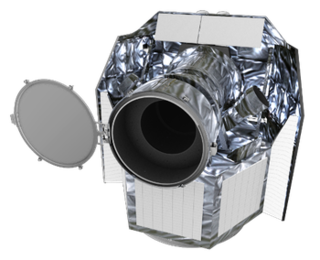
CHEOPS is a European space telescope. Its objective is to determine the size of known extrasolar planets, which will allow the estimation of their mass, density, composition and their formation. Launched on 18 December 2019, it is the first Small-class mission in ESA's Cosmic Vision science programme.

ULTRASAT is a space telescope in a smallsat format that will detect and monitor transient astronomical events in the near-ultraviolet (220–280 nm) spectral region. ULTRASAT will observe a large patch of sky with a 210 square degrees field of view, alternating every six months between the southern and northern hemisphere. The satellite is planned to be launched into a geosynchronous orbit in early 2026. All ULTRASAT data will be transmitted to the ground in real time. Upon detection of a transient event, ULTRASAT will provide alerts within 20 minutes to other ground-based and space telescopes to be directed to the source for further observation of the event in other wavelength bands.
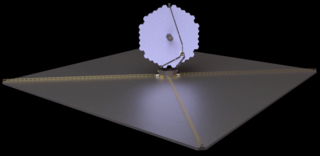
The Large Ultraviolet Optical Infrared Surveyor, commonly known as LUVOIR, is a multi-wavelength space telescope concept being developed by NASA under the leadership of a Science and Technology Definition Team. It is one of four large astrophysics space mission concepts studied in preparation for the National Academy of Sciences 2020 Astronomy and Astrophysics Decadal Survey.
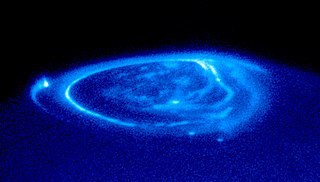
UVS, known as the Ultraviolet Spectrograph or Ultraviolet Imaging Spectrometer is the name of an instrument on the Juno orbiter for Jupiter. The instrument is an imaging spectrometer that observes the ultraviolet range of light wavelengths, which is shorter wavelengths than visible light but longer than X-rays. Specifically, it is focused on making remote observations of the aurora, detecting the emissions of gases such as hydrogen in the far-ultraviolet. UVS will observes light from as short a wavelength as 70 nm up to 200 nm, which is in the extreme and far ultraviolet range of light. The source of aurora emissions of Jupiter is one of the goals of the instrument. UVS is one of many instruments on Juno, but it is in particular designed to operate in conjunction with JADE, which observes high-energy particles. With both instruments operating together, both the UV emissions and high-energy particles at the same place and time can be synthesized. This supports the Goal of determining the source of the Jovian magnetic field. There has been a problem understanding the Jovian aurora, ever since Chandra determined X-rays were coming not from, as it was thought Io's orbit but from the polar regions. Every 45 minutes an X-ray hot-spot pulsates, corroborated by a similar previous detection in radio emissions by Galileo and Cassini spacecraft. One theory is that its related to the solar wind. The mystery is not that there are X-rays coming Jupiter, which has been known for decades, as detected by previous X-ray observatories, but rather why with the Chandra observation, that pulse was coming from the north polar region.

The Habitable Exoplanet Observatory (HabEx) is a space telescope concept that would be optimized to search for and image Earth-size habitable exoplanets in the habitable zones of their stars, where liquid water can exist. HabEx would aim to understand how common terrestrial worlds beyond the Solar System may be and determine the range of their characteristics. It would be an optical, UV and infrared telescope that would also use spectrographs to study planetary atmospheres and eclipse starlight with either an internal coronagraph or an external starshade.

The Lynx X-ray Observatory (Lynx) is a NASA-funded Large Mission Concept Study commissioned as part of the National Academy of Sciences 2020 Astronomy and Astrophysics Decadal Survey. The concept study phase is complete as of August 2019, and the Lynx final report has been submitted to the Decadal Survey for prioritization. If launched, Lynx would be the most powerful X-ray astronomy observatory constructed to date, enabling order-of-magnitude advances in capability over the current Chandra X-ray Observatory and XMM-Newton space telescopes.

ASTERIA was a miniaturized space telescope technology demonstration and opportunistic science mission to conduct astrophysical measurements using a CubeSat. It was designed in collaboration between the Massachusetts Institute of Technology (MIT) and NASA's Jet Propulsion Laboratory. ASTERIA was the first JPL-built CubeSat to have been successfully operated in space. Originally envisioned as a project for training early career scientists and engineers, ASTERIA's technical goal was to achieve arcsecond-level line-of-sight pointing error and highly stable focal plane temperature control. These technologies are important for precision photometry, i.e., the measurement of stellar brightness over time. Precision photometry, in turn, provides a way to study stellar activity, transiting exoplanets, and other astrophysical phenomena.

The Atmospheric Remote-sensing Infrared Exoplanet Large-survey (ARIEL) is a space telescope and the fourth medium-class mission of the European Space Agency's Cosmic Vision programme. The mission is aimed at observing at least 1000 known exoplanets using the transit method, studying and characterising the planets' chemical composition and thermal structures. Compared to the James Webb Space Telescope, ARIEL will be a much smaller telescope and have more observing time available for planet characterisation. ARIEL is expected to be launched in 2029 aboard an Arianespace Ariane 6 together with the Comet Interceptor.
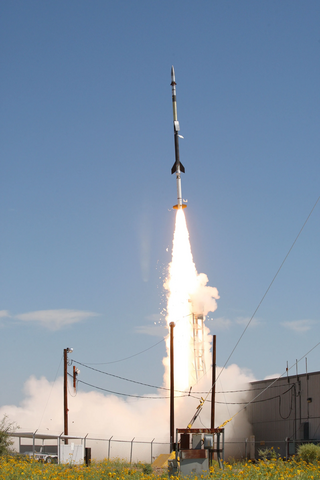
SISTINE is a NASA mission designed to study distant stars as a way of finding life on exoplanets.

Kevin France is an astrophysicist and assistant professor in the Department of Astrophysical and Planetary Sciences at the University of Colorado. His research focuses on exoplanets and their host stars, protoplanetary disks, and the development of instrumentation for space-borne astronomy missions.

The Ultraviolet Explorer (UVEX) is an upcoming wide-field ultraviolet space telescope from NASA scheduled to launch in 2030. UVEX will build off of previous ultraviolet space telescopes, specifically GALEX, conducting surveys of the entire sky in both near- and far-ultraviolet light. UVEX will study the evolution of low-metallicity stars and how they affect the evolution of low-metallicity and low-mass galaxies. The probe can also be used for quick-turnaround observation of cosmic events, such as merging stars. UVEX's data will be able to complement other all-sky survey programs in different wavelengths of light, notably those by the Vera C. Rubin Observatory, the Roman Space Telescope, and Euclid. Compared to earlier ultraviolet space telescopes, UVEX will feature more capable instrumentation and a larger mirror, enabling it to obtain higher-resolution data and observe fainter objects.
References
- 1 2 Johnston, Scott Alan (25 September 2021). "A Tiny, Inexpensive Satellite Will be Studying the Atmospheres of hot Jupiters". Universe Today . Retrieved 13 December 2021.
- ↑ Werner, Debra (12 December 2023). "Cubesat offers template for future astronomy missions". SpaceNews . Retrieved 13 December 2023.
- ↑ "Colorado Ultraviolet Transit Experiment (CUTE)". LASP . University of Colorado Boulder . Retrieved 13 December 2023.
- ↑ Fleming, Brian T.; et al. (2017). The Colorado Ultraviolet Transit Experiment (CUTE): a dedicated cubesat mission for the study of exoplanetary mass loss and magnetic fields. UV, X-Ray, and Gamma-Ray Space Instrumentation for Astronomy XX. Vol. 10397. Proceedings of SPIE. arXiv: 1801.02673v1 . doi:10.1117/12.2276138. ISBN 978-1-5106-1251-8.